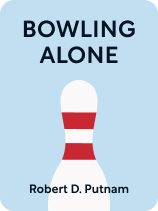

This article is an excerpt from the Shortform book guide to "Bowling Alone" by Robert D. Putnam. Shortform has the world's best summaries and analyses of books you should be reading.
Like this article? Sign up for a free trial here.
Are we experiencing a decline in community bonds? How can we reverse this societal trend and rebuild meaningful connections?
In his book Bowling Alone, Robert Putnam examines the erosion of social unity in America since the 1950s. He offers approaches through education, religious communities, neighborhood design, and internet technologies that could strengthen our communal ties.
Continue reading to discover Putnam’s vision for restoring social capital and creating a more connected society in the 21st century.
Rebuilding Social Unity
Putnam advocates a new wave of community-building efforts, creating new social structures for the 21st century that will restore and replenish our social unity in ways that acknowledge and make use of the progress we’ve made since the end of World War II. Putnam doesn’t presume to offer definitive solutions to our loss of social connection, but he suggests what sectors of society will have to be involved in addressing the problem.
(Shortform note: While Putnam keeps his focus firmly on the US, it may be that future social challenges and solutions will take place on a larger scale. In 21 Lessons for the 21st Century, Yuval Noah Harari argues that all humans are part of a global civilization that has connected the world economically, socially, and technologically. Therefore, Harari rejects nationalistic solutions to global problems such as the threat of war, environmental harm, and the ways in which modern technology is disrupting the sociopolitical landscape. These problems can’t be solved by any one nation, so Harari suggests that the communities and social institutions of the future must embrace the idea that the human race is a global entity.)
#1: The Education Approach
First, Putnam argues that change must start in school so that new generations can learn communal responsibility similar to that held by their great-grandparents. This would require drastic improvements to the current state of civics education, but it would also include providing students with ways to actively make a difference in their communities. He suggests that involving students in generating ideas for such programs would instill civic values even more strongly. At the time of writing (the late 1990s), Putnam noted an increase in young people volunteering for public causes that might reflect just such an upward trend.
(Shortform note: Civics education remains enough of an issue that in Battlegrounds, Gen. H.R. McMaster describes it as a matter of national security. He says that for the US to compete in the modern world, Americans young and old need to relearn how democracy works and how to engage in civil discussion. McMaster writes that by reengaging with the democratic process and American pluralism, divisions of race and culture can bolster society instead of weakening it. Putnam and McMaster aren’t alone—other educators and policy institutes have called for an increased emphasis on civics and public involvement in American education.)
#2: The Assembly Approach
Putnam also points out that churches remain some of the country’s strongest social capital creators and must therefore play a role in reforging social bonds. However, he admits that churches tend to focus on uniting people under one religious roof rather than connecting across the aisles of different faiths. If we’re to find a positive way to restore religious communities, Putnam writes that it will have to take a form that’s inclusive and tolerant of religious differences.
(Shortform note: An alternative to Putnam’s suggestion of revitalizing church congregations is to recreate the community-building aspects of organized religion in a secular setting. Groups such as Sunday Assembly are trying to fill that gap by holding gatherings similar to church services without any reference to supernatural beliefs. Sunday Assembly and other organizations, such as the Oasis Network, the Freethought Society, and Black Nonbelievers offer the growing non-religious population a way to build social capital outside of faith-based communities.)
#3: The Neighborhood Approach
Since suburban life plays such a large role in inhibiting social capital’s growth, Putnam says that city designers and urban planners need to build neighborhoods that increase social interactions while reducing commute times. Some such efforts were already underway at the time of Bowling Alone’s publication, but it was too soon for Putnam to draw any conclusions about their efficacy. Acknowledging the role that public policy plays in guiding urban and suburban development, he suggests that this task falls partly under the government’s purview.
(Shortform note: Restoring social capital isn’t the only problem facing 21st century urban planners—they must also deal with climate change, population growth, and traffic congestion. However, some of the proposed solutions could deal with several issues at once. For example, initiatives to reverse the urban “heat island” effect by introducing more parks and vegetation has the added benefit of creating more spaces for people to gather. Likewise, the boom of urban “live-work-play” housing addresses sustainability issues by placing many of the amenities people need in a central location adjacent to their home—which can also solve Putnam’s issue of how suburbs hinder community-building by physically distancing all of life’s activities.)
#4: The Internet Approach
Lastly, Putnam writes that any solutions to restoring social capital in the 21st century must involve the internet. When writing in 2000, the social uses of the internet remained unclear, and when updating the book for 2020, Putnam observed that online networks are most effective at creating social capital when they’re used as a binding supplement to traditional networks in the real world. As we move into the future, Putnam suggests that we can choose to use the internet in this way—not as a substitute for in-person interactions, but to build non-virtual communities that extend beyond the internet’s borders.
| The Antisocial Network Though people once hoped the internet would be a uniting influence on society, many now believe that it divides by creating online echo chambers where people only receive information tailored to their pre-existing beliefs. This is made worse by governments and groups that actively use the internet to spread misinformation. For online platforms to build social capital in the way that Putnam suggests, they would have to redesign their algorithms to promote positive interactions between people with different beliefs, reduce their emphasis on anger-provoking content, and clearly label content that misrepresents social divisions. While social media platforms may not ever do this, people can escape their social media bubbles by educating themselves on how algorithms work and deliberately choosing to step around them. This means not clicking on recommended links, actively searching for opposing viewpoints, and letting platforms access as little of your private information as possible. Many internet users, especially among younger generations, are leaving social media behind because of its negative impact on their lives. This can be difficult—people who leave social media often feel lonely and left-out at first, but those who bear with it find more time for the real-world connections that Putnam says are vital for society as a whole. |
Exercise: Has Social Unity Changed in Your Lifetime?
Putnam proposes that, at least in the US, collective social capital peaked in the 1950s and has dropped steadily since then. Think about whether your personal experience reflects this observation.
- When you were young, were you and your family involved in any organized social groups, whether as part of a church, a school, or your community in general? If so, what were they and how often did you participate?
- How often did you take part in informal gatherings, whether with friends or your extended family? What was the most common nature of those gatherings and how large did they tend to be?
- At present, how often do you attend social gatherings outside of work? What sort of gatherings are they? Do you feel as socially active today as when you were younger?
Exercise: How Might You Rebuild Social Unity?
Putnam suggests that the decline of social capital is a trend that won’t reverse itself on its own. On an individual level, consider any steps you might take to replenish social capital within the scope of your daily life.
- Are there any volunteer groups, hobbyist clubs, or professional organizations that you’d consider joining? If you already participate in such a group, is there a way you could become more active?
- How often do you hang out with friends, whether at a dinner party or some other social event? If you would like a more active social life, what sort of events would you be willing to host, even if only to take a friend to lunch?
- Within your current network of friends, family, and acquaintances, can you think of ways to bring people you know together who may not otherwise meet? Do you see any value in doing so, and why?

———End of Preview———
Like what you just read? Read the rest of the world's best book summary and analysis of Robert D. Putnam's "Bowling Alone" at Shortform.
Here's what you'll find in our full Bowling Alone summary:
- A look at how social capital in the US is breaking down
- The vital role of social capital in American life and the negative consequences of its decline
- Why the US can't return to the old social structures, and what it can do instead






